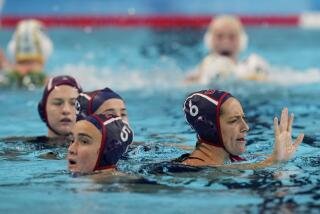America’s Cup Trials : Crewman Gets Wild Ride When Spinnaker Fills
- Share via
FREMANTLE, Australia — John Spence was down in the bowels of Buddy Melges’ Heart of America Tuesday--and then he was outside and in the water, just like that, wondering what had happened.
A spinnaker sail being raised filled prematurely and whisked him completely out through a hatch like a slingshot.
“It was blowing about 35 (knots), and we blew our chute out on the second reach,” said Spence, 22, the mastman. “We were going to put another one up, and the old chute was on top of the new chute and I was standing down below on the old chute.
“When they hauled the new spinnaker up, as soon as it filled, it just sucked me out of the hatch . . . like, ‘Going up to ladies’ apparel.’
“I was floating and I grabbed hold of the after guy (line). I was grabbing hold of anything of the spinnaker as it was dragging in the water. I was behind the boat when the spinnaker filled again, and I started body surfing and went up in front of the boat . . . went by the boat.”
Spence is a native of Jacksonville, Fla., and attends Furman University. His main thought in the water, he said, “was trying to figure out how I was gonna get back on. Then I couldn’t hold on anymore, so I dropped off and the Zodiac (an inflatable chase boat) picked me up.”
There was a time when America’s Cup races were sailed by gentlemen in ties and blazers, sipping tea on the gentle downwind runs. But when the wind blows off the Indian Ocean and down Gage Roads between Rottnet Island and the southwest coast of Australia, the perspective changes alarmingly.
The 12-meters, set up to the limits of the rules, already are wound as tight as their hardware will allow--often tighter, it seems--and in extreme conditions can become overloaded until their power must explode. That’s when sails shred and things start to break. Spence felt the force firsthand.
He should have had a premonition. As Heart of America left the dock that day, seven of the staff girls jumped into the water to wish the crew luck.
But Spence’s experience is only one of a daily series of dunkings and other near tragedies in the America’s Cup competition. Fellow crewman Andy Eddy, a grinder stationed farther aft, saw the whole thing.
“We were trying to pull the chute down,” Eddy said. “John was down below, hooking up the new chute, and we started hauling it up. I’d moved over to the mast to help our bowman, Bill Chamberlain, and the next thing I knew it was halfway up and started to fill.
“The clew (lower rear corner of of the spinnaker) came out and just pulled him out with it and took him about 20 feet out away from the boat. He came out of the hatch awfully quick.
“He hit the water at about the shrouds and then was back about 10 feet behind the end of the boat holding onto the spinnaker sheet. The next thing I knew he was going by me at about 30 m.p.h. Then the tension slacked a little bit and he sunk and went back to the end of the boat and grabbed onto another line and shot up to the front again.
“He was planing at about his waist and looking over at the boat, like . . . “ Eddy mimed a pair of big eyes.
Spence said: “At first I was scared. Then my next thought was how I was gonna get back to the boat without them having to come back to pick me up and waste all that time.”
The sailors try to prepare for anything but sometimes pay for a single slip.
“In panic situations it happens,” Spence said. “You get caught off guard and not thinking. That’s what happened.”
On that particular day, the wind was recorded at a steady 30 knots, with gusts even stronger.
“It’s not smart to race in this,” Spence said. “We had gusts of 38 knots. That’s almost 45 miles an hour (43.7). It’s kind of insane sailing in that stuff. It wasn’t fighting the other boat. It’s fighting Mother Nature, as Buddy says.”
America II skipper John Kolius said: “It’s as much as you want to sail in one of these things. Basically, a jibe is just a controlled crash. The boat’s in charge at that point.”
Kolius beat Britain’s White Crusader, whose skipper Harold Cudmore said, “Those conditions are about the limit. I don’t think any more than this would be sensible. You’re risking injury and perhaps losing somebody.”
There was some doubt whether races would be sailed that day. Finally, the defenders decided to go ahead in their separate trials . . . so how could the challengers not?
Gianfranco Alberini, as commodore of the Yacht Club Costa Smeralda, the challenger of record, is in charge of the challenger trials.
“My personal feeling was that it was very close to the limits,” he said. “But it’s good conditions for selecting the boats, to get the challengers ready for those conditions.”
Or a swim meet.
America’s Cup Notes
The challengers had a lay day Wednesday, and today’s races were called off because of unusual east-southeast offshore winds that would have caused the two shifted race courses to overlap--the first time that’s happened since the trials started Oct. 5. . . . White Crusader, unsuccessful in its first two protests against USA over Sunday’s race won by the San Francisco boat, has filed a third. This time the British are protesting about USA replacing its shattered front rudder after a race against Challenge France the previous Wednesday, claiming the new, larger rudder was not remeasured as required by the rules. If USA loses the protest, it could also forfeit wins over Stars & Stripes, Canada II and Azzurra, all subsequent to the Challenge France race, killing its chances of reaching the semifinals. The protest was being heard today. . . . The Kookaburras had a big day in the defender trials Wednesday. Third-place K-II trounced second-place Australia IV, which went dead in the water behind the line, started 33 seconds late and lost by 5:11, while first-place K-III defeated Steak’n Kidney by 0:26. The winds were a moderate 14 to 18 knots.


